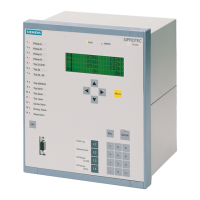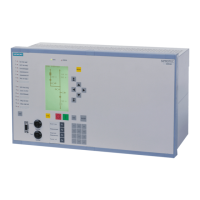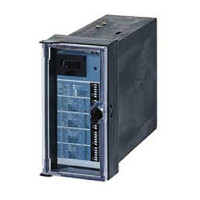[diff-stromdefinition-020926-rei, 1, en_GB]
Figure 2-20 Definition of current direction
•
Through-flowing current under undisturbed conditions or external fault:
Ι
1
flows into the protected zone, Ι
2
leaves the protected zone, i.e. is negative according tot he definition
of signs, therefore
Ι
2
= –Ι
1
;
moreover |Ι
2
| = |Ι
1
|
Ι
diff
= |
Ι
1
+ Ι
2
| = |Ι
1
– Ι
1
| = 0
Ι
stab
= |Ι
1
| + |Ι
2
| = |Ι
1
| + |Ι
1
| = 2 · |Ι
1
|
No tripping effect (Ι
diff
= 0); the stabilisation (Ι
stab
) corresponds to double the through-flowing current.
•
Internal short-circuit, e.g. fed with equal currents each side:
The following applies
Ι
2
= Ι
1
; außerdem ist |Ι
2
| = |Ι
1
|
Ι
diff
= |Ι
1
+ Ι
2
| = |Ι
1
+ Ι
1
| = 2 · |Ι
1
|
Ι
stab
= |Ι
1
| + |Ι
2
| = |Ι
1
| + |Ι
1
| = 2 · |Ι
1
|
Tripping effect (Ι
diff
) and restraint value (Ι
stab
) are equal and correspond to the total fault.
•
Internal short-circuit, fed from one side only:
The following applies Ι
2
= 0
Ι
diff
= |Ι
1
+ Ι
2
| = |Ι
1
+ 0| = |Ι
1
|
Ι
stab
= |Ι
1
| + |Ι
2
| = |Ι
1
| + 0 = |Ι
1
|
Tripping quantity (Ι
diff
) and restraint value (Ι
stab
) are equal and correspond to the single-sided fault
current.
This result shows that for internal fault Ι
diff
= Ι
stab
. Thus, the characteristic of internal faults is a straight line
with the slope 1 (45°) in the operation diagram (dash-dotted fault characteristic in Figure 2-21).
Functions
2.2 Differential Protection
94 SIPROTEC 4, 7UT6x, Manual
C53000-G1176-C230-5, Edition 09.2016
